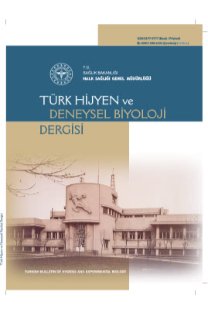Evaluation of immunoblotting test results in patients with positive antinuclear antibodies
Antinükleer antikorların pozitif saptandığı hastalarda immunoblotting test sonuçlarının değerlendirilmesi
___
1. Smeenk RJ. Antinuclear antibodies: cause of disease or caused by disease? Rheumatology, 2000;39(6):581-4.2. Yılmaz Ö, Karaman M, Ergon MC, Bahar İH, Yuluğ N. Konnektif doku hastalıklarının tanısında Antinükleer (ANA) veAnti-doublestran¬ded DNA (anti-dsDNA) antikorlarının önemi. T Parazitol Derg, 2005;29:287-290.
3. Afşar İ, Şener AG, Vural A, Hızlı N, Türker M. Anti nükleer antikorların pozitif saptandığı hastalarda immunoblotting test sonuçlarının değerlendirilmesi. Türk Mikrobiyol Cem Derg, 2007;37(1):39-42.
4. Meroni PL, Schur PH. ANA screening: an old test with new recommendations. Ann Rheum Dis, 2010;69:1420-2.
5. Au EY, Ip WK, Lau CS, Chan YT. Evaluation of a multiplex flow immunoassay versus conventional assays in detecting autoantibodies in systemic lupus erythematosus. Hong Kong Med J, 2018;24(3):261- 9.
6. Us D, Şener B, Hasçelik G, Günalp A. Investigation of the Presence of Antibodies to Extractable Nuclear Antigens (Anti-ENA) by Immunoblot Techniquen in Systemic Lupus Erythematosus Patients. Mikrobiyol Bul, 1997;31:155-63.
7. Damoiseaux JG, Tervaert JW. From ANA to ENA: How to Proceed? Autoimmunity Reviews, 2006;5(1):10-7.
8. Arnett FC, Edworthy SM, Bloch DA, McShane DJ, Fries JF, Cooper NS, et al. The american rheumatism association 1987 revised criteria for the classification of rheumatoid arthritis. Arthritis Rheum, 1988;31:315 – 24.
9. Vitali C, Bombardieri S, Jonsson R, Moutsopoulos HM, Alexander EL, Carsons SE, et al. Classification criteria for Sjogren’s syndrome: a revised version of the European criteria proposed by the American– European Consensus Group. Ann Rheum Dis, 2002;61:554 – 8.
10. 1Watson RM, Lane AT, Barnett NK, Bias WB, Arnett FC, Provost TT. Neonatal lupus erythematosus. A clinical, serological and immunogenetic study with review of the literature. Medicine (Baltimore), 1984;63:362–78.
11. Singsen BH, Akhter JE, Weinstein MM, Sharp GC. Congenital complete heart block and SSA antibodies: obstetric implications. Am J Obstet Gynecol, 1985;152:655–8.
12. Hu PQ, Fertig N, MedsgerJr TA, Wright TM. Correlation of serum anti-DNA topoisomerase I antibody levels with disease severity and activity in systemic sclerosis. Arthritis Rheum, 2003;48:1363– 73.
13. Güdücüoğlu H, Yaman G, Çıkman A, Çalışır U, Berktaş M. Retrospective evaluation of immunoblotting (IB) test results in anti-nuclear antibody positive patients. Turkish J Clin Lab, 2011;2:59-62.
14. Górniak G B, Rogacka N, Puszczewicz M. Antinuclear antibodies in healthy people and non-rheumatic diseases – diagnostic and clinical implications. Reumatologia, 2018; 56, 4: 243–8.
15. Li QZ, Karp DR, Quan J, Branch VK, Zhou J, Lian Y, veark. Risk factors for ANA positivity in healthy persons. Artritis Res Ther, 2011;13(2):R38.
16. Mengeloğlu Z, Taş T, Kocoglu E, Aktaş G, Karabörk S. Determination of anti-nuclear antibody pattern distribution and clinical relationship. Pak J Med Sci, 2014;30:380–3.
17. Çelikbilek N, Özdem B, Açıkgöz ZC. Evaluation of Anti-Nuclear antibody test results in clinical practice. J Microbiol Infect Diseas, 2015;5(2):63-8.
18. Karakeçe E, Atasoy AR, Çakmak G, ve ark. Bir üniversite hastanesinde antinükleer antiko rpozitiflikleri. Turk J Immunol, 2014;2:58.
19. Aktar GS, Ayaydın Z, Onur AR, Vural DG, Temiz H. Bir Eğitim ve Araştırma Hastanesinde İFA Yöntemiyle Çalışılan Otoantikor Sonuçlarının Retrospektif Olarak Değerlendirilmesi. Turk J Immunol, 2017; 5(3)77−81.
20. Agmon-Levin N, Damoiseaux J, Kallenberg C, Sack U, Witte T, Herold M, et al. International recommendations for the assessment of autoantibodies to cellular antigens referred to as anti-nuclear antibodies. Ann Rheum Dis, 2014;73:17–23
21. Kaklıkkaya N, Akıneden A, Topbaş M, Aydın F. Determination of anti-nuclear antibody seroprevalence in adult age groups in Trabzon province. Balkan Med J, 2013;30:343-4
22. Evrensel N, Arslan F, Gödekmerdan A. Antinükleer antikorların retrospektif olarak değerlendirilmesi. 2. Ulusal Klinik Mikrobiyoloji Kongresi. Kasım, 10– 13, Antalya-Türkiye. 2013
23. Yumuk Z, Çalışkan Ş, Gündeş S, Willke A. Anti- Nükleer antikorların araştırılması ve saptanmasında kullanılan teknikler. Türk Mikrobiyol Cem Derg, 2005;35(1):40-4
- ISSN: 0377-9777
- Yayın Aralığı: 4
- Başlangıç: 1938
- Yayıncı: Türkiye Halk Sağlığı Kurumu
Mehmet DOKUR, Mahmut DEMİRBİLEK, Mehmet KARADAĞ, Nüket GÜLER BAYSOY, Betül BORKU UYSAL
videos about malaria on YouTube: Evaluation of the Turkish and English content
Sümeyye KAZANCIOĞLU, Hürrem BODUR
Turhal Devlet Hastanesi’ne kene ısırması ile başvuran olguların değerlendirilmesi
Sedef Zeliha ÖNER, Emine TÜRKOĞLU
Geriatrik enfeksiyonların epidemiyolojisi ve mortaliteye etkili faktörler
Sabahat ÇEKEN, Duygu MERT, Göknur YAPAR TOROS, Yüksel KOLUKISA, Habip GEDİK, Gülşen İSKENDER, Mustafa ERTEK
Cenk Zeki FİKRET, Nil İrem UÇGUN, Filiz YILDIRIM, Enver AVCI, Mevlüt HAMAMCI
Kandidemide epidemiyolojik özellikler, risk faktörleri ve klinik gidişin değerlendirilmesi
Duru MISTANOĞLU ÖZATAĞ, Pınar KORKMAZ, Aynur GÜLCAN, Halil ASLAN, Şevket YALIN
Yasemin COŞGUN, Dilek MENEMENLİOĞLU, Ahmet SAFRAN, Burcu GÜRER GIRAY, Esma ÖDEVLI, Seda GÜDÜL HAVUZ, Erkan ÖZMEN, Ali Korhan SIĞ, Ahmet AYDEMİR, Dilek YAĞCI ÇAĞLAYIK, Gülay KORUKLUOĞLU, Seher TOPLUOĞLU, Selçuk KILIÇ
Van yöresinde izole edilen dermatofitlerde tür tayini
Cahit BABÜR, Banuçiçek YÜCESAN, Özcan ÖZKAN, Gül Bengisu GÜREL
